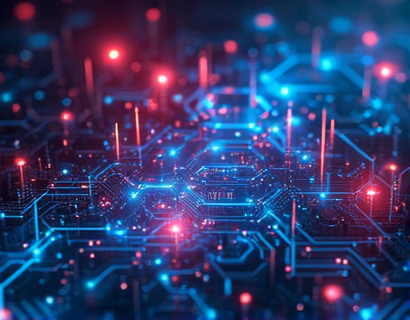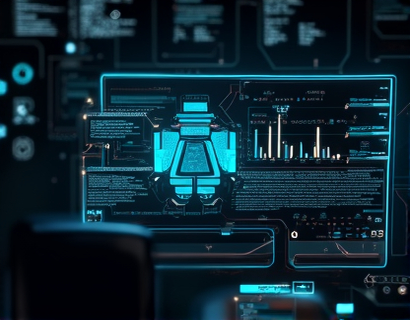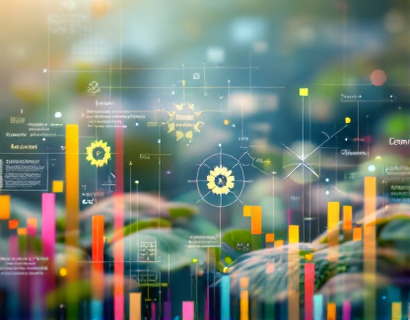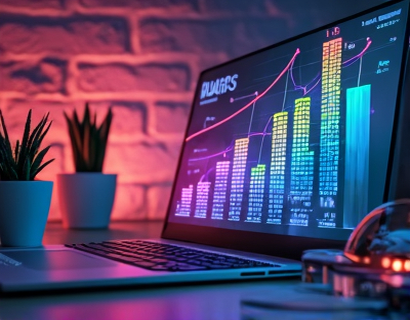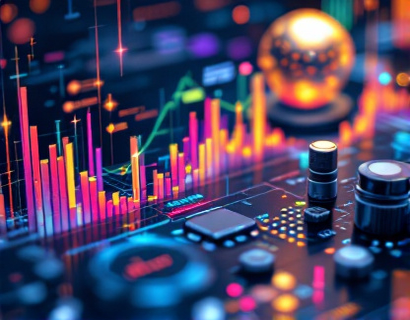Unlocking Digital Efficiency: Harnessing AI and Crypto for Next-Gen Productivity Solutions
The integration of Artificial Intelligence (AI) and cryptocurrency is revolutionizing the way we approach productivity and efficiency in the digital realm. This convergence of technologies is giving rise to a new generation of application solutions that are transforming daily tasks and workflows. For tech innovators and early adopters, this fusion opens up a world of possibilities, promising to streamline processes, enhance security, and unlock unprecedented levels of productivity. This article delves into the intricacies of how AI and cryptocurrency are merging to create the next wave of digital transformation, offering insights into the applications and benefits of these cutting-edge technologies.
The foundation of this digital revolution lies in the unique properties of cryptocurrency, particularly its decentralized nature and the underlying blockchain technology. Blockchain provides a secure, transparent, and immutable ledger that can be leveraged for various applications beyond cryptocurrency transactions. When combined with AI, which excels in pattern recognition, predictive analytics, and automation, the potential for innovation becomes immense. Together, these technologies can create robust, efficient, and secure systems that redefine productivity in the digital age.
Enhancing Security with AI and Crypto
One of the most significant advantages of integrating AI and cryptocurrency is the enhancement of security measures. Traditional security protocols can be vulnerable to breaches and hacks, but the combination of AI and blockchain offers a more robust defense mechanism. AI algorithms can monitor and analyze vast amounts of data in real-time, identifying anomalies and potential threats with high accuracy. This proactive approach to security is crucial in protecting sensitive information and ensuring the integrity of digital transactions.
Cryptocurrency, with its cryptographic algorithms, already provides a high level of security. However, when AI is applied to manage and secure blockchain networks, the security is further fortified. AI can detect and mitigate risks such as 51% attacks, where a group of miners control more than half of the network's hashing power, potentially allowing them to manipulate transactions. By using AI to monitor network activity, such threats can be identified and neutralized before they cause significant damage.
Moreover, AI-driven security solutions can adapt to new threats dynamically. Machine learning models can continuously learn from new data, improving their ability to recognize and respond to emerging risks. This adaptability is essential in the ever-evolving landscape of cyber threats, ensuring that systems remain secure and reliable over time. For businesses and individuals alike, this level of security is invaluable, providing peace of mind as they navigate the digital world.
Streamlining Workflows with AI-Powered Automation
AI and cryptocurrency are not only enhancing security but also revolutionizing workflow management. Automation, powered by AI, can significantly reduce the time and effort required to complete repetitive and mundane tasks. In a traditional setting, these tasks often involve manual data entry, scheduling, and reporting, which are prone to errors and inefficiencies. By automating these processes, AI can ensure accuracy, speed, and consistency, freeing up valuable time for more strategic and creative work.
Smart contracts, a key feature of blockchain technology, play a crucial role in this automation. Smart contracts are self-executing contracts with the terms of the agreement directly written into code. When combined with AI, these contracts can be programmed to trigger actions based on specific conditions, such as the completion of a task or the receipt of payment. This automation ensures that processes flow seamlessly, reducing the need for intermediaries and manual oversight.
For example, in project management, AI can monitor the progress of tasks and automatically deploy resources or trigger notifications when milestones are reached. In finance, smart contracts can automate payment processes, ensuring that transactions are executed only when predefined conditions are met. This level of automation not only increases efficiency but also reduces the potential for human error, leading to more reliable and trustworthy outcomes.
Optimizing Resource Allocation with AI and Crypto
Another critical area where AI and cryptocurrency intersect is in the optimization of resource allocation. Traditional resource management often relies on centralized systems that can be slow and inefficient. AI, combined with the decentralized nature of blockchain, can provide a more dynamic and responsive approach to resource allocation.
AI algorithms can analyze real-time data from various sources, such as sensor networks, market trends, and user behavior, to predict resource needs and optimize distribution. For instance, in supply chain management, AI can forecast demand, identify bottlenecks, and adjust inventory levels accordingly. This ensures that resources are used efficiently, reducing waste and lowering costs.
Cryptocurrency adds another layer of efficiency by facilitating seamless and transparent transactions. In a decentralized system, resources can be traded and allocated without the need for intermediaries, reducing transaction costs and speeding up processes. This is particularly beneficial in industries where timely resource allocation is critical, such as logistics and manufacturing.
Furthermore, the use of tokenized assets in blockchain can simplify ownership and management of resources. Tokens represent ownership or access rights to resources, making it easier to share and utilize assets across different parties. This tokenization can lead to more collaborative and efficient use of resources, fostering innovation and growth.
Enhancing User Experience through Personalization
AI and cryptocurrency are also transforming the way applications interact with users, providing highly personalized experiences. AI-driven analytics can process vast amounts of user data to understand preferences, behaviors, and needs. This insights-driven approach allows applications to tailor their services to individual users, enhancing satisfaction and engagement.
In the context of cryptocurrency, personalized experiences can extend to financial services. AI can analyze a user's transaction history and financial behavior to offer customized investment recommendations, budgeting tools, and financial advice. This level of personalization not only improves user experience but also builds trust and loyalty.
Moreover, the use of blockchain ensures that user data is secure and privacy is maintained. Users can have control over their data, deciding who can access it and for what purposes. This transparency and control are crucial in building user confidence in digital applications.
For instance, in a digital wallet application, AI can analyze a user's spending patterns to suggest savings opportunities or investment options. The wallet can also use blockchain to ensure that transactions are secure and traceable, providing users with a sense of security and reliability.
Driving Innovation through Decentralized Applications
Decentralized applications (dApps) are a prime example of how AI and cryptocurrency are driving innovation in the digital space. dApps leverage blockchain technology to operate on a decentralized network, eliminating the need for central authorities. This decentralized approach, combined with AI capabilities, opens up new possibilities for application development.
dApps can range from social media platforms to gaming environments, all designed to be more transparent, secure, and user-controlled. AI can enhance these applications by providing intelligent features such as chatbots, content recommendation systems, and automated moderation tools. These features not only improve the user experience but also ensure the smooth functioning of the application.
For developers, the integration of AI and blockchain offers a rich ecosystem for innovation. The open-source nature of many blockchain platforms allows developers to build upon existing frameworks, accelerating the development process. AI tools can assist in coding, testing, and optimizing dApps, making it easier to create sophisticated and scalable applications.
An example of a successful dApp is a decentralized finance (DeFi) platform that uses AI to offer personalized lending and borrowing services. The platform can analyze user creditworthiness, market conditions, and risk factors to provide tailored loan offers. This level of personalization and automation is not possible with traditional financial systems, making dApps a compelling choice for users seeking innovative financial solutions.
Challenges and Considerations
While the potential of AI and cryptocurrency in enhancing productivity is vast, there are several challenges and considerations that need to be addressed. One of the primary concerns is the regulatory landscape. The intersection of AI and cryptocurrency operates in a relatively uncharted territory, with varying regulations across different regions. Navigating these regulations is crucial for the widespread adoption of these technologies.
Another challenge is the technical complexity involved in integrating AI and blockchain. Developers need to have a deep understanding of both technologies to create effective and secure applications. This requires a skilled workforce and significant investment in research and development.
Additionally, there are concerns about the environmental impact of cryptocurrency, particularly proof-of-work (PoW) blockchains, which consume substantial amounts of energy. The adoption of more sustainable consensus mechanisms, such as proof-of-stake (PoS), can help mitigate these concerns. AI can also play a role in optimizing energy usage by efficiently managing computational resources.
Despite these challenges, the benefits of combining AI and cryptocurrency are undeniable. The potential to create more secure, efficient, and personalized digital solutions is driving innovation and adoption across various industries. As technology continues to evolve, we can expect to see even more groundbreaking applications that transform the way we work and live.
Conclusion
The convergence of AI and cryptocurrency is paving the way for a new era of digital productivity solutions. By enhancing security, streamlining workflows, optimizing resource allocation, personalizing user experiences, and driving innovation through decentralized applications, these technologies are reshaping the digital landscape. For tech innovators and early adopters, embracing this fusion offers a competitive edge and the opportunity to be at the forefront of digital transformation. As we continue to explore and harness the power of AI and cryptocurrency, the future of productivity looks brighter and more efficient than ever before.




